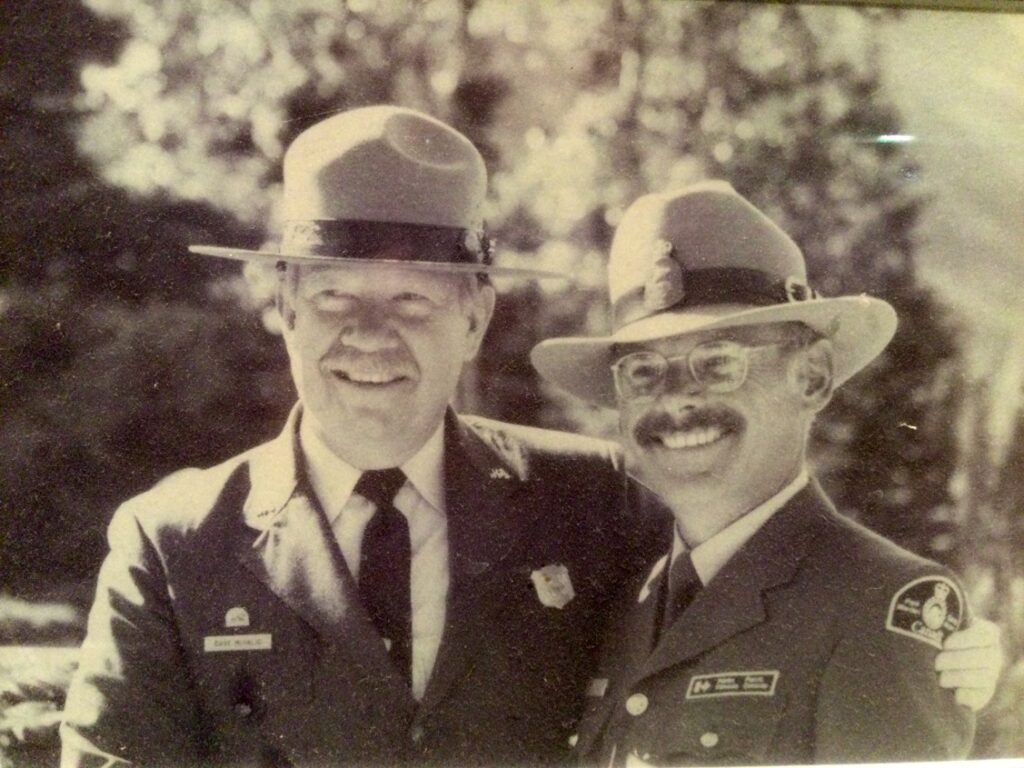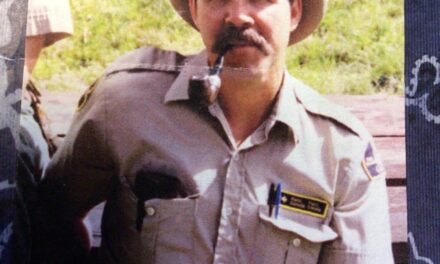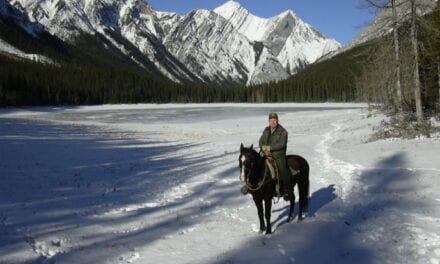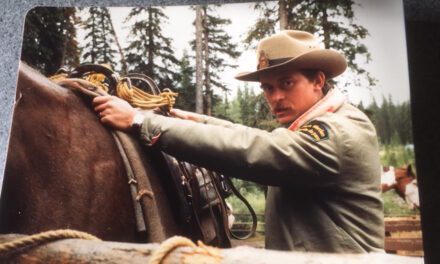This Oral History interview was funded in part by a research grant received in 2022 from the Government of Alberta through the Alberta Historical Resources Foundation. Park Warden Service Alumni Society of Alberta.
Oral History Project Phase 12 – Autumn 2022
Telephone Interview with Ian Syme
October 21, 2022 – 10:30 am MDT
Pender Island and Invermere, BC
Interviewed by Susan Hairsine
SH: What was the place and date of your birth?
Ian: I was born May 1952 in Regina Saskatchewan.
SH: A prairie boy. So where did you grow up?
Ian: I grew up in Regina, and went to university in Saskatoon, Saskatchewan, and got a BSc advanced in physical geography and biology. It went from there. This is kind of an interesting story I guess, and I think I related this at my retirement party. In the ‘60s I’m guessing, early to mid ‘60s, I was pretty young, maybe about ten or twelve. My brother and I did our first vacation away from our parents. I had an aunt and uncle and two cousins who lived in Jasper.
They drove us back to Jasper for a couple of weeks of hanging out with them, but my brother and I were pretty free range kids back in those days, probably like many, and we used to walk all over, not only the townsite but areas around the townsite out towards the lakes there, Jasper Park Lodge, and stuff. We took a gravel road one day and came across a big log barn, with mountains in the background, horses, and a bunch of guys sitting on the rails, green trucks, and I had to ask my uncle what that was all about and he said, “Well they’re park wardens and here’s what they do.” I was pretty much hooked. I always knew I wanted to do some sort of environmental work, but National Parks were definitely in the front of my mind. I kind of geared myself to becoming a park warden way back then.

I knew early what I wanted to do and felt very lucky I had some direction. I applied for Parks Canada in 1977 after graduation. There was no park warden competition that year, so I applied to be an interpreter. My first year in Jasper National Park was as a park interpreter. I went to interpreter school at the Palisades with the likes of Leslie Taylor and a few others that moved on to bigger things in Parks.
Interpretation at that point in time did hikes with people, did slideshow talks in campgrounds, and they did some pretty informal sessions at some of the smaller campgrounds which usually involved having a tea in the evening and talking to folks about the park and its critters and that sort of stuff. I actually quite enjoyed being an interpreter. It certainly gave me a chance to organize communication skills. My slideshow talk was about “Prescribed Burning”.
Sitting one evening in Wabasso Campground, south of Jasper on Highway 93A, a small campground, very peaceful, by the river I believe. Anyway, serving tea and having a discussion with a small group of people. I can’t remember how many were there, but suddenly somebody came running up and indicated that a man was attacking his friends with an axe, which as you can imagine created quite a stir. Since I was the only one in a Parks uniform for probably about 15 miles, I thought I should go and at least have a look. I don’t think we carried radios, in fact I know we didn’t, and cell phones certainly didn’t exist at that time. Probably there was a pay phone at the campground, I can’t really recall, but communication was certainly going to be an issue.
Anyway, I went and sure enough there was a fellow with an axe, not so much beating on his friends but beating on equipment. So with some of the other campers, we got everybody away from the immediate area while this fellow flailed on trailers and generators with his axe. I remember him whacking a generator and sparks flying, and all that kind of stuff.. but it was very much kind of a David and Goliath moment, where suddenly you realize there’s me and there’s him and likely folks expect something from you. Anyhow, he buried his axe into a trailer and couldn’t get it out, and I thought that was probably a good opportunity to at least approach him, which I did. This fellow was obviously in a drugged state, and he took a fairly uncoordinated kick at me. I was able to grab his foot and twisted it, and down he went onto the ground. I jumped on him and quite a few of the other male campers came running at that point and helped me pin him down. There was also some that probably had their generators chopped or whatever and were quite upset with this fellow and wanted their piece of him. So, I kind of indicated to folks they needed to back away or I would let him up again.
I forget the duration of time but Bill MacDonald, a warden in Jasper at that time, showed up and took charge, and I’m pretty sure the RCMP would have showed up, but I can’t really recall, as I think I left at that point, but anyway that was my first exposure to a significant event in a national park.
Later in my career when I was trying to get on the Warden Service, I seem to recall Bob Haney using a question on the seasonal park warden competition. “What would you do if you were in a campground and a guy started attacking”…
SH: How did you become involved in the Warden Service? Which national park did you start working in? Jasper? Do you want to run through your career at this point Ian?
Ian: I’ll do a quick summary of that. In ‘77 I was an interpreter, but I wanted to get on the Warden Service, so I hung around the warden office probably more than anywhere and got to know Bob Haney quite well. He was one of the area managers at that point in time, Duane Martin was as well, and after interp layoff I got hired on in the fall with a small crew to take down the phone line on the north boundary of Jasper National Park. There was four of us, one of them, Frank Staples, ran the horses for us, and we took down the phone line from Willow Creek right around the north boundary to Smoky which was a great job, and created lots of good experiences. Since I hadn’t skied much, I took the winter off and skied and got a little better at that. I was never a very stellar skier, but learned. I skied the North Boundary with Doug Eastcott, starting at Mount Robson and finishing at Willow Creek. Epic for me. Learned how to pack for a ski trip, or how not to pack. I took a hardcover book, jeans to slip into apres ski…DUMB. Doug was a strong ski tourer and I learned a lot. I also learned not to do big trips with too small borrowed boots.
The next summer I got hired as a patrolman in Willow Creek under North Boundary coordinator Brian Wallace. Bob Hansen and I were newbies and Rick West was at Smoky.… I was at Willow Creek and Bob was at Blue Creek. It was a pretty big adventure for us to say the least. That winter I drove a speed plow for Highways, and the next summer was in Tonquin Valley with Marv Miller as South Boundary Coordinator…and then speed plow again. I got a seasonal interview and was posted to Lake Louise, which coming from Jasper…going to Banff was viewed as a life sentence in purgatory. I was in Lake Louise from 1980 to 1983. When I first moved to Lake Louise, Mike McKnight was Area Manager. The Chateau wasn’t even open in the wintertime…so there was lots of change in the ‘80s that I was involved with, both in Lake Louise and Banff
I moved to Banff ….got a permanent job in Banff in 1984 I think, and I worked there both in the frontcountry and backcountry and at the Sunshine Ski area until about ‘86 or ‘87. Then back to Lake Louise where I did environmental assessments and monitoring for the Lake Louise Redevelopment Program. Lake Louise was rebuilding everything from the Chateau to the Post Hotel, the Visitor Centre, the mall, and the housing that was associated with it all.
Mike McKnight left to do environmental monitoring on the CPR twinning through Rogers Pass and I acted as the Area Manager in the late ‘80s. Lake Louise was somewhat autonomous at that time. There was a Townsite Manager, a Highways Manager, a Warden Service Manager and Interp. Service Manager. Don Huisman was the Highways Manager, Kim Fraser was the Townsite Manager, Mike from Canmore (Mike Kerr), was the Interp. Manager. We worked really collaboratively, and got an award from I think Charlie Zinkan, who was the Superintendent, for working together as such a good team there. However, all things that are good in Parks Canada sometimes don’t last long and there were big changes in the late ‘80s. Those positions disappeared and I landed into the Law Enforcement Coordinator role. Did that for maybe a year or a year and a half. In the early ‘90s things started to evolve for me in that I started to express interest in assignments outside of the Warden Service. I didn’t want to necessarily work in the Banff Warden Office one hundred percent of the time, I wanted to try some new things.
The first call came and I was asked to be an Acting Chief Warden in Yoho National Park after Paul Kutzer. With the almost immediate departure of Ian Church, Superintendent. I acted in that role. That was intense because they were starting to think about the Lake Louise, Kootenay, Yoho field unit experiment to take those management responsibilities in Lake Louise out of the Superintendent of Banff’s responsibilities. Charlie Zinkan was busy enough in Banff. I did that for about a year and a bit and then was asked to go down to Waterton to act as Superintendent there. I acted there for a couple of years. Then due to some changes in government departments, Parks Canada was in the Department of Heritage at the time, Heritage was taking some big cuts, and Parks Canada was moving towards an Agency. There were some impacted players from Department of Canadian Heritage, so I wasn’t able to compete on the Waterton Superintendent’s job, which while a disappointment ended up okay.
I came back to Banff after a bit of time off, about a two-month holiday. Bob Haney gave me some time off which was very good of him, and I came back to Banff as the Backcountry Manager, which was initially a bit of a setback not to be in the Superintendent kind of role, but I realized that becoming the Backcountry Manager of Banff was a pretty spectacular role too. I did that for a couple of years. In the late ‘90s, Perry Jacobson was the Chief Park Warden in Banff then, and when Perry retired, there was a competition for Chief Warden’s job. Actually, there was a competition for Banff and maybe Jasper and maybe even Lake Louise, Kootenay, Yoho, I forget, but I got to be Chief Warden in Banff which I did from late 1999 til I retired in 2010. And that’s it in a nutshell.
SH: You sort of answered this, but do you want to add anything more to what made you want to join the Warden Service?
Ian: I think the reality for me was that in Jasper….Jasper in the late ‘70s as a community and for work. That office was a bunch of relatively recent grads from the Northern Alberta Institute of Technology (NAIT) or Saskatoon, or the Southern Alberta Institute of Technology (SAIT). Parks and Warden Service were starting to move into an educational requirement and there was some pretty great people around, a mix of the old and new, some amazing people. Jasper was a pretty nice introduction to the Warden Service and the camaraderie of it.
Lake Louise was a wonderful place to work and Mike McKnight was a great boss. He gave me lots of opportunities. I was a seasonal, but I never actually did seasonal work. I worked year round pretty much until I got my permanent job. It far exceeded my expectations of what the job was going to be like. I think that goes for just about everybody that chose a career in the Warden Service. It was really the perfect job. When I talk to my friends on Pender Island and mention I was a park warden in Banff and Lake Louise, those parts of the country, they have no idea what you actually did, but since it was Banff the job was recognized as being quite something and it was quite something.
SH: What different parks did you work in? How did they compare? Do you have a favourite?
Ian: The parks I worked in were strictly mountain parks. I was offered jobs elsewhere, Gwaii Haanas and a couple of other places, but I stuck to the mountains and was glad I did. It was a great place to work for me anyways. Great people.
SH: So do you have a favourite park Ian?
Ian: They were all different enough that …. no I’m not going to say I had a favourite place. I had great experiences in all of the places I worked.
When I was working in Yoho I actually lived in Lake Louise and drove down the hill every day, but I did get some sense of what Field and the Park were like. Dedicated to the park kind of staff. In Waterton, there was about 40 people who lived in town in winter and probably 25 of them were Parks Canada staff. Waterton had a pretty unique relationship both with the ranchers on the periphery and with Glacier National Park in the US system. It made that place pretty special. Good staff down there again. But you know I think from an organizational perspective, Banff turned out to be a great place to work. The great thing about Banff was I was fortunate enough to have exceptional managers in Charlie Zinkan, and Bill Fisher and Jillian Roulet who trusted and supported the Warden Service, and lot of things happened and were required to happen after the Bow Valley Study. We will get into that in a little bit, about all sorts of change.
When one thinks about all the change that happened from 1980 through 2010, some particularly great advancements kept the Warden Service really active. There was no down time in Banff. It was a busy place. As we used to say, just about anything that happens made the national news in Banff.
That was brought home right away, because by about a month or a month and a half after I started as Chief Park Warden, a young woman was killed by a cougar up by Lake Minnewanka and I suddenly realized the spotlight that could be put on Banff, that’s for sure.

SH: What were some of your main responsibilities over the years?
Ian: I touched on that a little bit. Certainly my days in Lake Louise, being part of that whole redevelopment…. There was a Parks Manager in Lake Louise in charge of the Lake Louise Redevelopment named Jervis Swanneck. Jervis and I got along really well. Many didn’t. I did things like environmental assessments for the Parks developments and the environmental monitoring of other developments. The Post Hotel redevelopment, Chateau … you know a lot of things changed in Lake Louise…
I’ll continue on with the responsibilities. Sorry for digressing!
Law Enforcement coordinator’s position, I wasn’t necessarily focused on law enforcement, but it was an interesting time. Lot’s of support from Duane Martin. John Steele was Warden Manager there, and we did some fun things like a plain clothes operation at Bow Lake at the opening of fishing season. We always had a suspicion that people were taking more fish back to Calgary, the regulars that came out to fish Bow Lake opening. We had people across the lake with high powered binoculars watching people fish the shore, and plainclothes wardens on the shoreline. When fishers had made multiple trips from shoreline back to their vehicle we went in and checked vehicles for possession limits, stuff like that. It created quite a stir, needless to say but it was a fun operation.
Other responsibilities included Backcountry Manager in Banff. Perry (Jacobson) was backcountry portfolio manager for Mountain Parks and we coordinated with the backcountry managers in Jasper, Lake Louise Kootenay and Yoho, Banff, Revelstoke/Glacier and Waterton. We worked pretty closely in defining standards and those sorts of things. I really, really enjoyed that. Perry was visionary and brought in things like social sciences to backcountry management. We (Banff) also had significant fallout from the Bow Valley Study and subsequent management plan to carry through on.



